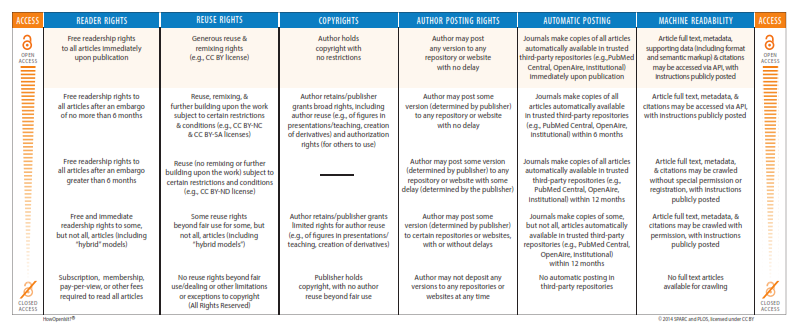Open Access : Creative Commons licences
Related resources
This resource describes the various aspects of 'Open Access', including reuse rights. These rights (for authors and readers) are affected by the type of licence applied to the work. For example a resource might be freely available to read online, but you are not allowed to redistribute it elsewhere. Or you may be allowed to use in teaching, but not in a commercial context.
Finding CC-licensed material
NOTE: Whenever you find content online, you should verify that its licence is legitimate and check the exact terms of reuse.
SEARCH: Try filtering your results in Google by selecting an option from 'usage rights' in Advanced Search
Try various search engines on the Creative Commons website
IMAGES: Explore CC-licensed images on flickr
About Creative Commons
Creative Commons is an international nonprofit organisation that enables the sharing and use of creativity and knowledge through free legal tools. The CC movement is based on the notion of “some rights reserved”, providing a balance between creators and consumers of intellectual property. The concept allows clear indication of how work may be used, reused and distributed, while ownership remains in the control of authors and copyright owners.
Learn more at https://creativecommons.org/about/
Key points
- Publishers and creators of content can use Creative Commons licences to ensure authors get acknowledgement.
- Readers can easily understand how they can reuse CC-licensed content.
- CC uses ready-made licences covering creative content, learning materials and open access scholarly publications.
- CC licences are designed in 3 'layers', with legal language, human-readable text and machine readable code.
- 'Attribution' is at the heart of all CC lcences: CC licences require that you attribute the original author(s).
"The Creative Commons copyright licences and tools forge a balance inside the traditional “all rights reserved” setting that copyright law creates. Our tools give everyone from individual creators to large companies and institutions a simple, standardised way to grant copyright permissions to their creative work."
Read about the licences at https://creativecommons.org/licenses/
Creative Commons licences use simple, standard icons. For example the basic 'Attribution' licence known as CC-BY looks like this:
Guides to Creative Commons for authors
-
Guide to Creative Commons for Humanities and Social Science Monograph AuthorsProduced by by JISC Collections as part of the OAPEN-UK project, this guide addresses common queries and concerns expressed by authors when choosing appropriate licences. The guide has been edited by active researchers, to make sure that it is relevant and useful to academics faced with making decisions about publishing.
The following links will help authors understand the requirements of some research funders, and find answers to some common concerns:
-
UKRI open access policyThe new policy relates to: articles submitted after 1 April 2022, and long-form works published after 1 January 2024. This page links to guidance on the policy and FAQs.
-
Wellcome Trust FAQ on CC-BYInformation for authors on the requirement for Creative Commons Attribution licences on Wellcome Trust-funded research articles.
-
Wellcome Trust FAQ on CC for booksInformation for authors on the requirement for Wellcome-funded monographs and book chapters to be licensed under Creative Commons licences. They will accept non-commercial and/or no-derivatives versions (ie CC-BY-NC or CC-BY-NC-ND)
-
Response to concerns about using CC licencesIn the UK, the House of Commons has asked for feedback on their Open Access Policy. One provision of that policy requires that articles funded through the Research Councils UK (RCUK) must be released under a CC BY license. The Creative Commons organisation has pulled together some clarifications to some of the uncertainty lobbed at the CC BY license provision in the Open Access Policy.
Using Creative Commons
Before licensing: Things to consider before applying a Creative Commons licence to your work
Choose licences: How to choose and apply a Creative Commons licence
In addition to the basic 'Attribution' requirement, you can choose to limit how people can reuse your work. For example you can add a 'non-commercial' clause to prohibit re-use for commercial purposes. The 'CC BY-NC' licence looks like this:
Attributing CC-licensed work
See how to properly attribute material offered under a Creative Commons licence.
Find out how to correctly attribute CC-licensed images at https://foter.com/blog/how-to-attribute-creative-commons-photos/

How To Attribute Creative Commons Photos by Foter
Contact us
Please email:


